This glossary provides an overview of terms used in the description of lichens, composite organisms arising from algae or cyanobacteria living symbiotically among filaments of multiple fungus species.[1][2]
Erik Acharius, known as the "father of lichenology," coined many lichen terms still in use today around the turn of the 18th century. Before that, only a couple of lichen-specific terms had been proposed. Johann Dillenius introduced scyphus in 1742 to describe the cup-shaped structures associated with genus Cladonia, while in 1794 Michel Adanson used lirella for the furrowed fruitbodies of the genus Graphis. Acharius introduced numerous terms to describe lichen structures, including apothecium, cephalodium, cyphellae, podetium, proper margin, soredium, and thallus. In 1825, Friedrich Wallroth published the first of his multi-volume work Naturgeschichte der Flechten ("Natural History of Lichens"), in which he proposed an alternative terminology based largely on roots from the Greek language. His work, presented as an alternative to that of Acharius (of whom he was critical) was not well received, and the only terms he proposed to gain widespread acceptance were epi- and hypophloeodal, hetero- and homoiomerous, and gonidium, the last of which remained in use until the 1960s.[3] Until about 1850, there were 21 terms for features of the lichen thallus that remain in use today.[3]
The increasing availability of the optical microscope as an aid to identifying and characterizing lichens led to the creation of new terms to describe structures that were previously too small to be visualized. Contributions were made by Julius von Flotow (e.g. epithecium), Edmond Tulasne (e.g pycnidium), and William Nylander (e.g. pseudocyphella, thecium). Gustav Wilhelm Körber, an early proponent of using spore structure as a character in lichen taxonomy, introduced amphithecium, muriform, and "polari-dyblastae", later anglicized to "polari-bilocular" and then shortened to polarilocular.[4] In the next five decades that followed, many other additions were made to the repertoire of lichen terms, subsequent to the increased understanding of lichen anatomy and physiology made possible by microscopy. For whatever reasons, there were not any new terms (still currently used) introduced from the period 1906 to 1945, when Gustaf Einar Du Rietz proposed replacing epi- and hypothecium with epi- and subhymenium; all four terms remain in use.[4] In some cases, older terminology became obsolete as better understanding of the nature of the fungal–algal relationship led to changes in their terminology. For example, after Gunnar Degelius objected to the use of gonidia for the algal partner, George Scott proposed the use of mycobiont and phycobiont for lichen components, recommendations that were generally accepted by lichenologists.[5]
This glossary includes terms defining features of lichens unique to their composite nature, such as the major components the two major components of lichens (mycobiont and photobiont); specialized structures in lichen physiology; descriptors of types of lichens; two- and three-dimensional shapes used to describe spores and other lichen structures; terms of position and shape; prefixes and suffixes commonly used to form lichen terms; terminology used in methods for the chemical identification of lichens; the names of 22 standard insoluble lichen pigments and their associated reference species; and "everyday" words that have a specialized meaning in lichenology. The list also includes a few historical terms that have been supplanted or are now considered obsolete. Familiarity with these terms is helpful for understanding older literature in the field.
- a-
- Also an-. A prefix meaning "not having" or "without".[6]
- ab-
- A prefix meaning "positioned away from".[6]
- abortive
- Referring to a developmental process in lichens where certain structures, such as spores or reproductive organs, fail to reach full development or maturity, often resulting in non-viable or malformed structures.[7]
- abraded
- Having a worn or eroded thallus surface.[8]
- accessory substance
- A lichen product that is sometimes present, sometimes not present in a species. In literature, these are usually indicated with a ± symbol, e.g. ±usnic acid.[9]
- -aceae
- A suffix used to indicate the taxonomic rank of family.[10]
- -aceous
- A suffix used to indicate a relation or similarity to something.[10]
- acervulate
- Shaped like a saucer.[11]
- acicular
- Also aciculiform. Needle-shaped; long and slender with a taper at both ends. Typically used to describe spore shape.[12]
- acro-
- Also acr-. A prefix used to indicate that something is positioned on the end or the upper part.[13]
- acrogenous
- Developing on the apex of a structure.[14]
- acroton
- A needle-shaped structure with lateral branches.[8]
- actinolichen
- A lichen-like association between an actinobacterium (Streptomyces) and a green alga (Chlorella xantha).[15]
- acuminate
- Gradually tapering to a point.[16]
- ad-
- A prefix used to indicate positioning at the end or on an extremity.[17]
- adglutinated
- Stuck together.[18]
- adnate
- Having a tight attachment to a surface.[19]
- adventive branching
- Referring to fruticose lichens, a branching pattern that is unusual or abnormal, like that which sometimes occurs after the original branches are damaged in Cladonia.[8]
- -al
- A suffix used to indicate a relation to, or having the form and character of something.[20]
- alectorioid lichen
- An informal growth form category used for lichens that are fruticose, typically with beard-like thalli that are pendant or clustered; this group of features is characteristic of lichens now classified in the genera Alectoria, Bryoria, Oropogon, Pseudephebe, and Sulcaria.[21]
- algal layer
- Also photobiont layer.[22] The layer of tissue in a heteromerous lichen thallus that contains the photobiont; it is typically located between the upper cortex and the medulla.[23]
- alveolate
- Used to describe a surface that has a pattern similar to a honeycomb (i.e. with more or less 6-sided hollows), where the surface appears to be composed of small pits or cavities like alveoli.[24] Compare: faveolate, foveolate, scrobiculate.
- amphi-
- A prefix used to indicate on both sides, or on all sides.[25]
- amphithecium
- Plural amphithecia. The thalline margin of a lecanorine apothecium;[26] equivalent to the thalline exciple.[27] The amphithecium usually contains algal cells.[22] The term was coined by Wilhelm Körber in 1855, but languished in obscurity until 1898, when Otto Darbishire used it in a monograph of the genus Roccella.[28]
- ampliotremoid
- A morphotype of corticolous thelotremoid lichens used to describe characteristics of apothecial and thallus morphology. Ampliotremoid lichens have prominent apothecia with wide pores, black walls (viewed in microscopic section), and a smooth, more or less shiny thallus; this morphotype occurs in the genera Ampliotrema and Ocellularia.[29]
- ampulliform
- Bottle-shaped, i.e., with a narrow neck and swollen base.[30]
- amyloid
- Turn a purple or blue color upon reaction with Melzer's reagent.[31]
- anisotomic
- Also anisotomous.[32] Having branches of unequal length;[33] if the branching is anisotomic, one branch is typically stouter than the other, forming a main stem while the other appears like a lateral branch, as in the species Alectoria ochroleuca.[32] Contrast: dichotomous.
- annulotremoid
- A morphotype of corticolous thelotremoid lichens used to describe characteristics of apothecial and thallus morphology. Annulotremoid lichens have prominent apothecia with wide pores, pores with an inner ring, and a smooth, more or less shiny thallus; this morphotype occurs in the genera Myriotrema and Thelotrema.[29]
- anticlinal
- Perpendicular to a surface;[34] used to refer to hyphal alignment.
- apical
- Located at the highest point (the apex), the tip, or the end of something.[35]
- apiculate
- Having a short projection (an apicule) at one end; typically used to describe spore morphology.[36]
- apothecium
- Plural apothecia. A type of ascocarp that is open, saucer-shaped or cup-shaped, and in which the hymenium is exposed at maturity.[37] The term was first used by Erik Acharius in 1803.[3]
- appressed
- Lying flat; flattened down on a surface.[38]
- arachnoid
- Also araneose, araneous.[39] Having a cobweb-like form, like that of the irregularly oriented and loosely interwoven hyphae of the medullary layer of some lichens.[40]
- Arceutina-yellow
- A pale yellow insoluble lichen pigment, associated with the reference species Bacidia arceutina.[41]
- arcuate
- A shape or structure that is curved or arched like a bow.[42]
- ardella
- Plural ardelae. A type of apothecium, typical of lichens in the family Arthoniaceae, which is small and round. Elongated ardellae are called lirellae.[43] The term was first used by William Allport Leighton in 1854, who described an ardella as resembling a "sprinkled spot".[4]
- areole
- Plural areolae. A small area, typically rounded to polygonal or irregular in shape, and often with a distinct texture. In a lichen thallus, the areolae are often separated from the rest of the thallus by fissures or cracks.[44]
- areolate
- Also areolar. The condition of being made of or covered with areolae, such as the areolate lichens.[44]
- Arnoldiana-brown
- A reddish-brown insoluble insoluble lichen pigment, associated with the reference species Bacidina arnoldiana.[45]
- ascigerous
- Having asci.[46]
- asco-
- A prefix meaning "ascus".[46]
- ascocarp
- Also ascoma, plural ascomata. The fruiting body of an ascomycete fungus, containing the asci and ascospores.[47]
- ascoconidium
- Plural ascoconidia. A conidium that is formed directly from an ascospore.[48]
- ascogenous
- Also ascogenic. Producing or supporting the growth of an ascus.[46]
- ascolichen
- A lichen in which the fungal partner (the mycobiont) is a member of the Ascomycota. About 98% of lichens are ascolichens.[49] See related: basidiolichen.
- ascospore
- A sexual, haploid spore produced in an ascus.[50]
- ascus
- Plural asci. A sexual, fungal spore-bearing structure, typically sac-like.[51]
- aseptate
- Lacking septa.[46]
- aspicilioid
- Referring to lecanorine apothecia that are (at least initially) partially to completely immersed in the thallus.[52]
- astomate
- Also astomous. Lacking an opening, or ostiole.[46]
- astrothelioid
- Referring to a type of ascospore morphology prevalent in the genus Astrothelium; characterized by thick-walled distosepta and diamond-shaped lumina.[53]
- -ate
- A suffix, added to nouns, used to indicate having the appearance or characteristics of that noun.[54]
- Atra-brown
- A matt brown insoluble lichen pigment, associated with the reference species Opegrapha atra.[55]
- Atra-red
- A dark red insoluble lichen pigment, associated with the reference species Tephromela atra.[56]
- aulaxinoid
- A morphotype of corticolous thelotremoid lichens used to describe characteristics of apothecial and thallus structure. This term refers to a morphotype of lichen where the apothecia are partially embedded and partially protruding, having a dark, hardened thalline margin that forms irregular cracks. This morphotype is uniquely seen in "Thelotrema" dislaceratum, a species with uncertain taxonomic placement.[57]
A

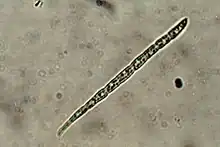
_Coppins_%2526_Scheid._590040.jpg.webp)

B
C
_Figure_3C.jpg.webp)




D
.jpg.webp)
E

.jpg.webp)
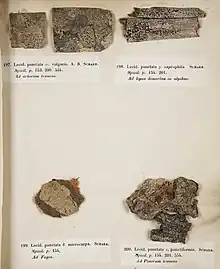
F



G
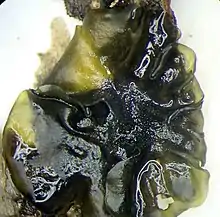
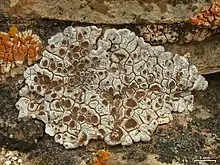
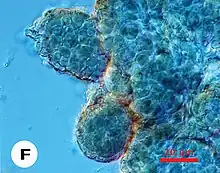
H

I
.jpg.webp)
J
K
L
.jpg.webp)

M
.jpg.webp)

N
O

P
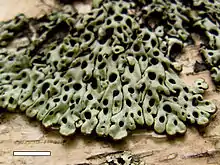

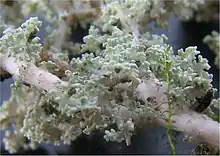
.jpg.webp)
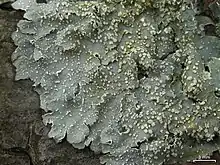
.jpg.webp)
R
S

.jpg.webp)
.jpg.webp)
T
_A._Massal_409112.jpg.webp)
.jpg.webp)

U
.jpg.webp)
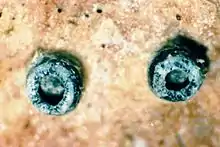
V

X

Z
See also
Citations
- ↑ "Introduction to Lichens". 2014-08-22. Archived from the original on 2014-08-22. Retrieved 2022-07-24.
- ↑ "What is a lichen? - Lichen website". 2014-07-02. Archived from the original on 2014-07-02. Retrieved 2022-07-24.
- 1 2 3 4 5 6 7 8 9 10 11 12 13 14 15 16 17 Mitchell 2014, p. 13.
- 1 2 3 4 5 6 7 8 9 10 11 12 Mitchell 2014, p. 14.
- 1 2 3 4 5 6 7 8 9 10 11 12 13 14 15 16 17 18 19 20 21 22 Mitchell 2014, p. 15.
- 1 2 Kirk et al. 2008, p. 1.
- ↑ Ulloa & Hanlin 2012, p. 3.
- 1 2 3 Cannon & Kirk 2007, p. 384.
- 1 2 Orange, James & White 2001, p. 6.
- 1 2 Ulloa & Hanlin 2012, p. 4.
- 1 2 Smith et al. 2009, p. 22.
- ↑ Ulloa & Hanlin 2012, p. 6.
- ↑ Ulloa & Hanlin 2012, p. 9.
- ↑ Kirk et al. 2008, p. 7.
- ↑ Ulloa & Hanlin 2012, p. 8.
- ↑ Kirk et al. 2008, p. 9.
- ↑ Ulloa & Hanlin 2012, p. 7.
- 1 2 3 Øvstedal & Lewis Smith 2001, p. 367.
- ↑ Brodo, Sharnoff & Sharnoff 2001, p. 755.
- ↑ Ulloa & Hanlin 2012, p. 16.
- ↑ Thell et al. 2012, pp. 645, 655.
- 1 2 Brodo 2016, p. 369.
- ↑ Cannon & Kirk 2007, p. 385.
- ↑ Kirk et al. 2008, p. 23.
- ↑ Ulloa & Hanlin 2012, p. 20.
- ↑ Kirk et al. 2008, p. 26.
- ↑ Ryan et al. 2022, page: Amphithecium.
- ↑ Mitchell 2014, pp. 14–15.
- 1 2 3 4 5 6 7 8 9 10 11 12 13 14 15 16 17 18 19 20 21 22 23 Mercado-Díaz et al. 2015, p. 16.
- ↑ Ulloa & Hanlin 2012, p. 21.
- ↑ Ulloa & Hanlin 2012, p. 22.
- 1 2 Ulloa & Hanlin 2012, p. 26.
- ↑ Ryan et al. 2022, page: Anisotomic.
- ↑ Kirk et al. 2008, p. 40.
- ↑ Ulloa & Hanlin 2012, p. 30.
- ↑ Kirk et al. 2008, p. 42.
- ↑ Kirk et al. 2008, p. 44.
- ↑ Kirk et al. 2008, p. 45.
- ↑ Cannon & Kirk 2007, p. 387.
- ↑ Ulloa & Hanlin 2012, p. 36.
- 1 2 3 4 Meyer & Printzen 2000, p. 582.
- 1 2 3 4 5 6 7 8 9 MacKenzie Lamb 1968, p. 85.
- ↑ Ulloa & Hanlin 2012, p. 37.
- 1 2 Ulloa & Hanlin 2012, p. 38.
- 1 2 Meyer & Printzen 2000, p. 578.
- 1 2 3 4 5 Cannon & Kirk 2007, p. 388.
- ↑ Ulloa & Hanlin 2012, p. 41.
- ↑ Kirk et al. 2008, p. 54.
- 1 2 Honegger 1991, p. 555.
- ↑ Ulloa & Hanlin 2012, p. 42.
- ↑ Silverstein, Silverstein & Silverstein 1996, p. 32.
- ↑ Cannon & Kirk 2007, p. 63.
- ↑ Nelsen et al. 2014, p. 982.
- ↑ Ulloa & Hanlin 2012, p. 48.
- 1 2 3 4 5 6 Meyer & Printzen 2000, p. 579.
- 1 2 3 Meyer & Printzen 2000, p. 581.
- ↑ Rivas Plata et al. 2010, p. 141.
- ↑ Ulloa & Hanlin 2012, pp. 54–55.
- 1 2 3 4 Meyer & Printzen 2000, p. 580.
- 1 2 Ulloa & Hanlin 2012, p. 60.
- ↑ Cannon & Kirk 2007, p. 390.
- 1 2 Ulloa & Hanlin 2012, p. 61.
- 1 2 Nelsen et al. 2020, p. 21496.
- ↑ Ryan et al. 2022, page: Biseriate.
- ↑ Ulloa & Hanlin 2012, p. 68.
- 1 2 3 4 5 Brodo, Sharnoff & Sharnoff 2001, p. 756.
- ↑ Poelt 1980.
- ↑ Grube & Hawksworth 2007, p. 1117.
- 1 2 Randlane et al. 2009, p. 421.
- ↑ Ryan et al. 2022, page: Branchlet.
- 1 2 3 4 5 6 7 British Lichen Society.
- ↑ Lendemer, Buck & Harris 2016, p. 441.
- ↑ Upreti & Rai 2013, p. 2.
- ↑ Kirk et al. 2008, p. 106.
- ↑ Ulloa & Hanlin 2012, p. 77.
- ↑ Ahmadjian & Hale 1973, p. 635.
- ↑ Ulloa & Hanlin 2012, p. 81.
- ↑ Ulloa & Hanlin 2012, p. 82.
- ↑ Øvstedal & Lewis Smith 2001, p. 368.
- ↑ Kirk et al. 2008, p. 114.
- ↑ Ulloa & Hanlin 2012, p. 84.
- ↑ Ulloa & Hanlin 2012, p. 89.
- ↑ Smith et al. 2009, p. 24.
- ↑ Ulloa & Hanlin 2012, p. 92.
- ↑ Breuss 2010.
- ↑ Kirk et al. 2008, p. 121.
- ↑ Kirk et al. 2008, p. 122.
- ↑ Cannon & Kirk 2007, p. 392.
- ↑ Ahmadjian & Hale 1973, p. 49.
- 1 2 3 Ulloa & Hanlin 2012, p. 98.
- 1 2 Thell et al. 2012, p. 645.
- 1 2 3 Weber & Büdel 2011, p. 348.
- ↑ Ryan et al. 2022, page: Checklist.
- ↑ Kirk et al. 2008, p. 135.
- ↑ Ryan et al. 2022, page: Chlorococcoid.
- ↑ Kirk et al. 2008, p. 143.
- ↑ Meyer & Printzen 2000, pp. 580–581.
- ↑ Ulloa & Hanlin 2012, p. 106.
- 1 2 Smith et al. 2009, p. 13.
- ↑ Ahti 1982, p. 105.
- ↑ Ulloa & Hanlin 2012, p. 107.
- ↑ Kirk et al. 2008, p. 153.
- ↑ Ryan et al. 2022, page: Coccoid.
- ↑ Kirk et al. 2008, p. 162.
- 1 2 Kirk et al. 2008, p. 163.
- ↑ Ulloa & Hanlin 2012, p. 122.
- 1 2 Brodo, Sharnoff & Sharnoff 2001, p. 757.
- ↑ Ulloa & Hanlin 2012, p. 124.
- ↑ Ulloa & Hanlin 2012, p. 121.
- ↑ Büdel & Scheidegger 2008, p. 64.
- 1 2 Mitchell 2014, p. 16.
- ↑ Kirk et al. 2008, p. 170.
- 1 2 Kirk et al. 2008, p. 172.
- 1 2 Kirk et al. 2008, p. 173.
- ↑ Ulloa & Hanlin 2012, p. 133.
- ↑ Kirk et al. 2008, p. 176.
- ↑ Ulloa & Hanlin 2012, p. 134.
- ↑ North American Mycological Association.
- ↑ Brodo 2016, p. 371.
- 1 2 Hertel 2009, p. 185.
- ↑ Hafellner & Kalb 1995, pp. 163–164.
- ↑ Hafellner & Kalb 1995, p. 163.
- ↑ Kirk et al. 2008, p. 1842.
- ↑ Kirk et al. 2008, p. 184.
- ↑ Kirk et al. 2008, p. 183.
- ↑ Rikkinen 2015, p. 973.
- ↑ Kirk et al. 2008, p. 187.
- ↑ Ryan et al. 2022, page: Decorticate.
- ↑ Kirk et al. 2008, p. 196.
- ↑ Ulloa & Hanlin 2012, p. 151.
- 1 2 Ulloa & Hanlin 2012, p. 152.
- ↑ Ulloa & Hanlin 2012, p. 153.
- ↑ Ulloa & Hanlin 2012, p. 156.
- ↑ Kirk et al. 2008, p. 201.
- 1 2 Ulloa & Hanlin 2012, p. 157.
- ↑ Brodo 2016, p. 372.
- ↑ Ferraro 2004, p. 154.
- ↑ Ulloa & Hanlin 2012, p. 162.
- ↑ Brodo, Sharnoff & Sharnoff 2001, p. 293.
- ↑ Ulloa & Hanlin 2012, p. 163.
- 1 2 Ulloa & Hanlin 2012, p. 166.
- ↑ Ulloa & Hanlin 2012, p. 167.
- ↑ Kirk et al. 2008, p. 216.
- ↑ Korf 1962, p. 25.
- ↑ Kirk et al. 2008, p. 217.
- 1 2 Cannon & Kirk 2007, p. 399.
- ↑ Ulloa & Hanlin 2012, p. 170.
- 1 2 Ulloa & Hanlin 2012, p. 175.
- ↑ Ulloa & Hanlin 2012, p. 176.
- ↑ Ulloa & Hanlin 2012, p. 177.
- ↑ Kirk et al. 2008, p. 226.
- ↑ Büdel & Scheidegger 2008, p. 42.
- ↑ Kirk et al. 2008, p. 228.
- 1 2 Smith et al. 2009, p. 31.
- ↑ Ulloa & Hanlin 2012, p. 182.
- ↑ Ulloa & Hanlin 2012, p. 183.
- 1 2 Ulloa & Hanlin 2012, p. 184.
- 1 2 3 Kirk et al. 2008, p. 338.
- ↑ Kirk et al. 2008, p. 231.
- ↑ Kirk et al. 2008, p. 232.
- ↑ Ulloa & Hanlin 2012, p. 185.
- ↑ Ulloa & Hanlin 2012, p. 186.
- 1 2 Ulloa & Hanlin 2012, p. 188.
- ↑ Ulloa & Hanlin 2012, p. 190.
- ↑ Kirk et al. 2008, p. 237.
- 1 2 Kirk et al. 2008, p. 240.
- 1 2 Ulloa & Hanlin 2012, p. 197.
- 1 2 Kirk et al. 2008, p. 241.
- 1 2 3 Kirk et al. 2008, p. 461.
- ↑ Ulloa & Hanlin 2012, p. 199.
- ↑ Ryan et al. 2022, page: Epiphloedal.
- ↑ Galloway 2022.
- ↑ Ulloa & Hanlin 2012, p. 200.
- ↑ Øvstedal & Lewis Smith 2001, p. 369.
- ↑ Ulloa & Hanlin 2012, p. 203.
- 1 2 3 4 Aptroot & Lücking 2016, p. 774.
- ↑ Kirk et al. 2008, p. 246.
- ↑ Cannon & Kirk 2007, p. 401.
- ↑ Ryan et al. 2022, page: Eucortex.
- ↑ Ulloa & Hanlin 2012, p. 211.
- ↑ Ulloa & Hanlin 2012, pp. 207–208.
- ↑ Ulloa & Hanlin 2012, p. 216.
- ↑ Diederich, Lawrey & Ertz 2018, p. 342.
- ↑ Ulloa & Hanlin 2012, pp. 216–217.
- 1 2 3 Brodo, Sharnoff & Sharnoff 2001, p. 758.
- 1 2 Ulloa & Hanlin 2012, p. 218.
- 1 2 Ulloa & Hanlin 2012, p. 219.
- 1 2 Moncada, Lücking & Betancourt-Macuase 2013, p. 2015.
- ↑ Ulloa & Hanlin 2012, p. 220.
- 1 2 Ulloa & Hanlin 2012, p. 221.
- ↑ Kirk et al. 2008, p. 256.
- ↑ Cannon & Kirk 2007, p. 402.
- ↑ Ulloa & Hanlin 2012, p. 222.
- 1 2 Ulloa & Hanlin 2012, p. 224.
- ↑ Ulloa & Hanlin 2012, p. 225.
- ↑ Ryan et al. 2022, page: Fissurine.
- ↑ Rivas Plata et al. 2010, pp. 141–142.
- ↑ Cannon & Kirk 2007, p. 412.
- 1 2 3 4 Ulloa & Hanlin 2012, p. 226.
- ↑ Ulloa & Hanlin 2012, p. 227.
- ↑ Ulloa & Hanlin 2012, p. 229.
- ↑ Ulloa & Hanlin 2012, pp. 229–230.
- ↑ Kirk et al. 2008, p. 260.
- ↑ Rapai, McMullin & Newmaster 2012.
- ↑ Fraser, Pouliot & van der Sluijs 2021.
- ↑ Ulloa & Hanlin 2012, pp. 231.
- ↑ Moncada, Lücking & Betancourt-Macuase 2013, p. 205.
- ↑ Kirk et al. 2008, p. 263.
- ↑ Ryan et al. 2022, wart page: Fruit wart.
- 1 2 3 4 Ulloa & Hanlin 2012, p. 239.
- ↑ Ryan et al. 2022, page: Fuscocapitate.
- ↑ Kirk et al. 2008, p. 270.
- ↑ Ryan et al. 2022, page: Fuzzy coat.
- ↑ Kirk et al. 2008, p. 271.
- 1 2 Büdel & Scheidegger 2008, p. 41.
- ↑ Ulloa & Hanlin 2012, p. 247.
- 1 2 Ulloa & Hanlin 2012, p. 252.
- ↑ Ulloa & Hanlin 2012, p. 255.
- 1 2 Ulloa & Hanlin 2012, p. 256.
- ↑ Kirk et al. 2008, p. 288.
- 1 2 3 Ulloa & Hanlin 2012, p. 257.
- 1 2 3 Kirk et al. 2008, p. 290.
- ↑ Ulloa & Hanlin 2012, p. 260.
- ↑ Kirk et al. 2008, p. 294.
- 1 2 Ulloa & Hanlin 2012, p. 262.
- ↑ Ulloa & Hanlin 2012, p. 263.
- ↑ Ulloa & Hanlin 2012, p. 264.
- ↑ Ryan et al. 2022, page: Hafter.
- ↑ Ryan et al. 2022, page: Halo.
- ↑ Ryan et al. 2022, page: Halonate.
- 1 2 Ulloa & Hanlin 2012, p. 268.
- ↑ Ulloa & Hanlin 2012, p. 273.
- ↑ Ulloa & Hanlin 2012, p. 274.
- ↑ Ulloa & Hanlin 2012, p. 275.
- ↑ Ulloa & Hanlin 2012, p. 278.
- ↑ Ulloa & Hanlin 2012, p. 280.
- ↑ Ulloa & Hanlin 2012, p. 282.
- ↑ Ulloa & Hanlin 2012, p. 283.
- ↑ Ulloa & Hanlin 2012, p. 284.
- ↑ Ryan et al. 2022, page: Hormocyte.
- ↑ Ulloa & Hanlin 2012, p. 285.
- ↑ Ulloa & Hanlin 2012, p. 288.
- ↑ Kirk et al. 2008, p. 328.
- ↑ Ulloa & Hanlin 2012, p. 294.
- ↑ Ulloa & Hanlin 2012, p. 295.
- ↑ Goward 1986, p. 219.
- 1 2 Ulloa & Hanlin 2012, p. 296.
- 1 2 Kirk et al. 2008, p. 335.
- 1 2 3 4 5 6 7 8 MacKenzie Lamb 1968, p. 86.
- 1 2 3 Ulloa & Hanlin 2012, p. 301.
- ↑ Ulloa & Hanlin 2012, p. 303.
- 1 2 3 Brodo, Sharnoff & Sharnoff 2001, p. 759.
- ↑ Ryan et al. 2022, page: Inspers.
- ↑ Ryan et al. 2022, page: Inspersion.
- ↑ Ulloa & Hanlin 2012, p. 310.
- 1 2 Ulloa & Hanlin 2012, p. 313.
- ↑ Randlane et al. 2009, p. 422.
- ↑ Ryan et al. 2022, page: Isotomic.
- ↑ Ulloa & Hanlin 2012, p. 315.
- ↑ Brodo 2016, p. 374.
- ↑ Ahmadjian & Hale 1973, p. 636.
- 1 2 Ahmadjian & Hale 1973, p. 637.
- 1 2 3 4 Øvstedal & Lewis Smith 2001, p. 371.
- 1 2 Kirk et al. 2008, p. 358.
- ↑ Kirk et al. 2008, p. 359.
- 1 2 Krzewicka 2004, p. 7.
- ↑ Rivas Plata et al. 2010, pp. 143–144.
- ↑ Ryan et al. 2022, page: Lax.
- ↑ Ulloa & Hanlin 2012, p. 336.
- ↑ Ulloa & Hanlin 2012, p. 337.
- ↑ Kirk et al. 2008, p. 367.
- ↑ Rivas Plata et al. 2010, pp. 145–146.
- ↑ Ulloa & Hanlin 2012, p. 339.
- 1 2 Kirk et al. 2008, p. 376.
- 1 2 Ulloa & Hanlin 2012, p. 341.
- ↑ Kirk et al. 2008, p. 382.
- ↑ Ulloa & Hanlin 2012, p. 346.
- ↑ Ryan et al. 2022, page: Lirellate.
- ↑ Kirk et al. 2008, p. 389.
- ↑ Ulloa & Hanlin 2012, p. 347.
- ↑ Brodo, Sharnoff & Sharnoff 2001, pp. 759–760.
- 1 2 Kirk et al. 2008, p. 391.
- ↑ Ulloa & Hanlin 2012, p. 352.
- ↑ Ulloa & Hanlin 2012, p. 357.
- ↑ Ulloa & Hanlin 2012, p. 358.
- ↑ Ahmadjian & Hale 1973, p. 46.
- 1 2 Brodo, Sharnoff & Sharnoff 2001, p. 760.
- ↑ Kirk et al. 2008, p. 402.
- ↑ Kirk et al. 2008, p. 412.
- ↑ Meyer & Printzen 2000, pp. 581–582.
- ↑ Rivas Plata et al. 2010, p. 582.
- ↑ Ryan et al. 2022, page: Micareoid.
- ↑ Orange, James & White 2001, p. 40.
- ↑ Cannon & Kirk 2007, p. 414.
- ↑ Ulloa & Hanlin 2012, p. 374.
- ↑ Kirk et al. 2008, p. 435.
- ↑ Kirk et al. 2008, p. 437.
- ↑ Ulloa & Hanlin 2012, p. 389.
- ↑ Ulloa & Hanlin 2012, p. 390.
- ↑ Ulloa & Hanlin 2012, p. 392.
- ↑ Cannon & Kirk 2007, p. 415.
- ↑ Collins English Dictionary 2022a.
- ↑ Nash 2008, p. 1.
- ↑ Hawksworth 1988, pp. 4–5.
- ↑ Kirk et al. 2008, p. 451.
- 1 2 3 Kirk et al. 2008, p. 477.
- ↑ Ulloa & Hanlin 2012, p. 428.
- ↑ Kirk et al. 2008, p. 479.
- ↑ Ulloa & Hanlin 2012, p. 432.
- ↑ Kirk et al. 2008, p. 488.
- ↑ Ulloa & Hanlin 2012, p. 439.
- ↑ Kirk et al. 2008, p. 489.
- 1 2 Ulloa & Hanlin 2012, p. 442.
- ↑ Ulloa & Hanlin 2012, pp. 442–443.
- 1 2 Ulloa & Hanlin 2012, p. 444.
- ↑ Ulloa & Hanlin 2012, p. 445.
- ↑ Ulloa & Hanlin 2012, p. 446.
- ↑ Cannon & Kirk 2007, p. 419.
- ↑ Ulloa & Hanlin 2012, p. 448.
- ↑ Ulloa & Hanlin 2012, pp. 448–449.
- 1 2 Ulloa & Hanlin 2012, p. 449.
- ↑ Kirk et al. 2008, p. 497.
- ↑ Ulloa & Hanlin 2012, p. 452.
- ↑ Kirk et al. 2008, p. 503.
- ↑ Ulloa & Hanlin 2012, p. 455.
- ↑ Ulloa & Hanlin 2012, p. 454.
- ↑ Ulloa & Hanlin 2012, p. 457.
- ↑ Kirk et al. 2008, p. 508.
- 1 2 Ulloa & Hanlin 2012, p. 459.
- 1 2 Ulloa & Hanlin 2012, p. 460.
- ↑ Smith et al. 2009, p. 30.
- ↑ Ulloa & Hanlin 2012, p. 463.
- ↑ Mitchell 2014, p. 17.
- 1 2 Sanders 2004, p. 269.
- ↑ Ryan et al. 2022, page: Phenocortex.
- ↑ Collins English Dictionary 2022b.
- ↑ Ulloa & Hanlin 2012, p. 471.
- ↑ Laundon 1995.
- ↑ Ulloa & Hanlin 2012, p. 470.
- ↑ Kirk et al. 2008, p. 527.
- 1 2 Ulloa & Hanlin 2012, p. 475.
- ↑ Kirk et al. 2008, p. 528.
- ↑ Kistenich et al. 2018, p. 872.
- ↑ Ulloa & Hanlin 2012, p. 482.
- ↑ Jagtap, Tripathi & Joshi 2013, p. 342.
- ↑ Rivas Plata et al. 2010, p. 143.
- ↑ Kirk et al. 2008, p. 544.
- ↑ Ulloa & Hanlin 2012, p. 487.
- ↑ Ryan et al. 2022, page: Plicate.
- 1 2 Ulloa & Hanlin 2012, p. 490.
- ↑ McCune & Wang 2014, p. 28.
- ↑ Ulloa & Hanlin 2012, p. 492.
- ↑ Kirk et al. 2008, p. 553.
- 1 2 3 Øvstedal & Lewis Smith 2001, p. 372.
- ↑ Rivas Plata et al. 2010, pp. 148–149.
- 1 2 3 Kirk et al. 2008, p. 646.
- ↑ Ryan et al. 2022, page: Prominent.
- ↑ Kirk et al. 2008, pp. 250, 562.
- 1 2 Ulloa & Hanlin 2012, p. 506.
- ↑ Ulloa & Hanlin 2012, p. 507.
- ↑ Ulloa & Hanlin 2012, p. 510.
- 1 2 3 Ulloa & Hanlin 2012, p. 511.
- ↑ Ryan et al. 2022, page: Pruina.
- ↑ Kirk et al. 2008, p. 566.
- ↑ Ryan et al. 2022, page: Pseudocortex.
- ↑ Ulloa & Hanlin 2012, p. 513.
- ↑ Kirk et al. 2008, p. 568.
- ↑ Ulloa & Hanlin 2012, p. 514.
- 1 2 Ulloa & Hanlin 2012, p. 515.
- ↑ Ulloa & Hanlin 2012, p. 517.
- ↑ Smith et al. 2009, p. 36.
- ↑ Kirk et al. 2008, p. 573.
- ↑ Kirk et al. 2008, p. 581.
- ↑ Kirk et al. 2008, p. 582.
- ↑ Ulloa & Hanlin 2012, p. 522.
- ↑ Ulloa & Hanlin 2012, p. 523.
- 1 2 Brodo, Sharnoff & Sharnoff 2001, p. 762.
- 1 2 Ulloa & Hanlin 2012, p. 525.
- ↑ Cannon & Kirk 2007, p. 582.
- ↑ Ulloa & Hanlin 2012, p. 526.
- ↑ Ulloa & Hanlin 2012, p. 527.
- ↑ Ulloa & Hanlin 2012, p. 533.
- 1 2 Kirk et al. 2008, p. 588.
- ↑ Ulloa & Hanlin 2012, p. 541.
- ↑ Ryan et al. 2022, page: Recurved.
- ↑ Kirk et al. 2008, p. 595.
- ↑ Ulloa & Hanlin 2012, p. 548.
- 1 2 Kirk et al. 2008, p. 597.
- 1 2 3 Smith et al. 2009, p. 38.
- ↑ Ulloa & Hanlin 2012, p. 549.
- ↑ Ulloa & Hanlin 2012, p. 552.
- 1 2 Ulloa & Hanlin 2012, p. 553.
- ↑ Ulloa & Hanlin 2012, pp. 553–554.
- ↑ Ulloa & Hanlin 2012, p. 555.
- ↑ Kirk et al. 2008, p. 607.
- ↑ Meyer & Printzen 2000, pp. 579–580.
- 1 2 Ulloa & Hanlin 2012, p. 558.
- ↑ Kirk et al. 2008, p. 610.
- ↑ Rivas Plata et al. 2010, p. 144.
- ↑ Ulloa & Hanlin 2012, p. 565.
- 1 2 Ulloa & Hanlin 2012, p. 567.
- ↑ Scott 1957, p. 487.
- ↑ Kirk et al. 2008, p. 627.
- ↑ Randlane et al. 2009, p. 423.
- ↑ Ulloa & Hanlin 2012, p. 574.
- ↑ Ryan et al. 2022, page: Seriate.
- ↑ Kirk et al. 2008, p. 632.
- ↑ Ulloa & Hanlin 2012, p. 580.
- ↑ Ulloa & Hanlin 2012, p. 581.
- ↑ Kantvilas 2023.
- 1 2 3 Øvstedal & Lewis Smith 2001, p. 373.
- 1 2 3 Ulloa & Hanlin 2012, p. 586.
- ↑ Kirk et al. 2008, p. 645.
- ↑ Lücking, Leavitt & Hawksworth 2021.
- ↑ Kirk et al. 2008, p. 647.
- 1 2 Ulloa & Hanlin 2012, p. 596.
- ↑ Ulloa & Hanlin 2012, p. 598.
- ↑ Ryan et al. 2022, page: Spongiostratum.
- ↑ Kirk et al. 2008, p. 657.
- ↑ Wirth & Hale Jr. 1978, p. 2, .
- ↑ Smith et al. 2009, pp. 383–384.
- ↑ Ahmadjian & Hale 1973, pp. 633–634.
- 1 2 Ulloa & Hanlin 2012, p. 610.
- ↑ Brodo, Sharnoff & Sharnoff 2001, p. 763.
- ↑ Ulloa & Hanlin 2012, p. 621.
- ↑ Kirk et al. 2008, p. 670.
- 1 2 3 Kirk et al. 2008, p. 671.
- ↑ Ulloa & Hanlin 2012, p. 625.
- ↑ Ulloa & Hanlin 2012, p. 627.
- ↑ Kirk et al. 2008, p. 672.
- 1 2 3 Ulloa & Hanlin 2012, p. 629.
- 1 2 Ulloa & Hanlin 2012, p. 639.
- ↑ Smith 1921, p. xxii.
- ↑ Smith 1921, p. 24.
- ↑ Ulloa & Hanlin 2012, p. 642.
- ↑ Ulloa & Hanlin 2012, p. 644.
- ↑ Kirk et al. 2008, pp. 250, 684.
- ↑ Ulloa & Hanlin 2012, p. 646.
- 1 2 3 4 Ulloa & Hanlin 2012, p. 647.
- ↑ Kirk et al. 2008, p. 684.
- ↑ Poelt & Obermayer 1990.
- ↑ Kantvilas & Jarman 1999, p. 206.
- ↑ Dobson 2011, p. 482.
- ↑ Kirk et al. 2008, p. 685.
- 1 2 Papong et al. 2010, p. 131.
- ↑ Ulloa & Hanlin 2012, p. 171.
- ↑ Ulloa & Hanlin 2012, p. 653.
- ↑ Büdel & Scheidegger 2008, p. 54.
- ↑ Rivas Plata et al. 2010, pp. 146–147.
- ↑ Ryan et al. 2022, page: Trentepohlioid.
- ↑ Ryan et al. 2022, page: Trebouxioid.
- 1 2 Ulloa & Hanlin 2012, p. 663.
- ↑ Büdel & Scheidegger 2008, p. 43.
- ↑ Ulloa & Hanlin 2012, p. 669.
- ↑ Ulloa & Hanlin 2012, p. 670.
- 1 2 3 Ulloa & Hanlin 2012, p. 673.
- 1 2 Ulloa & Hanlin 2012, p. 674.
- ↑ Rivas Plata et al. 2010, p. 147.
- ↑ Ulloa & Hanlin 2012, p. 675.
- ↑ Thell et al. 2012, p. 655.
- ↑ Orange, James & White 2001, pp. 10, 47.
- ↑ Büdel & Scheidegger 2008, p. 46.
- 1 2 Ulloa & Hanlin 2012, p. 682.
- ↑ Ulloa & Hanlin 2012, p. 683.
- 1 2 Ulloa & Hanlin 2012, p. 687.
- ↑ Ryan et al. 2022, page: Verruciform.
- ↑ Kirk et al. 2008, p. 724.
- ↑ Australian National Herbarium.
- ↑ Tripp 2017, p. 152.
- ↑ Ulloa & Hanlin 2012, p. 700.
- ↑ Kirk et al. 2008, p. 742.
- ↑ "Record Details: Zeora Fr., Syst. orb. veg. (Lundae) 1: 244 (1825)". Index Fungorum. Retrieved 4 December 2022.
- ↑ Ryan et al. 2022, page: Zeorine.
- ↑ Cannon & Kirk 2007, p. 437.
Sources
- "Vitricolous lichens – Lichen website". Australian National Botanic Gardens - Botanical Web Portal. Australian National Herbarium. 20 October 2009. Retrieved 18 October 2022.
- "Definition of mycobiont". Collins English Dictionary. 2022a. Retrieved 23 July 2022.
- "Definition of phycobiont". Collins English Dictionary. 2022b. Retrieved 23 July 2022.
- Ahmadjian, Vernon; Hale, Mason E. (1973). The Lichens. New York: Academic Press. ISBN 978-0-12-044950-7.
- Ahti, T. (1982). "The morphological interpretation of cladoniiform thalli in lichens". The Lichenologist. 14 (2): 105–113. doi:10.1017/s0024282982000255. S2CID 86304863.
- Aptroot, André; Lücking, Robert (2016). "A revisionary synopsis of the Trypetheliaceae (Ascomycota: Trypetheliales)". The Lichenologist. 48 (6): 763–982. doi:10.1017/s0024282916000487.
- Breuss, Othmar (2010). "An updated world-wide key to the catapyrenioid lichens (Verrucariaceae)". Herzogia. 23 (2): 205–216. doi:10.13158/heia.23.2.2010.205. S2CID 86842145.
- Brodo, Irwin M.; Sharnoff, Sylvia Duran; Sharnoff, Stephen (2001). Lichens of North America. New Haven, Connecticut: Yale University Press. ISBN 0-300-08249-5.
- Brodo, Irwin (2016). "Glossary". Keys to Lichens of North America: Revised and Expanded. New Haven, Connecticut: Yale University Press. pp. 369–382. ISBN 978-0-300-19573-6.
- Cannon, Paul F.; Kirk, Paul M. (2007). Fungal Families of the World. Wallingford: CABI. ISBN 978-0-85199-827-5. OCLC 60741230.
- Diederich, Paul; Lawrey, James D.; Ertz, Damien (2018). "The 2018 classification and checklist of lichenicolous fungi, with 2000 non-lichenized, obligately lichenicolous taxa". The Bryologist. 121 (3): 340–425. doi:10.1639/0007-2745-121.3.340. S2CID 92396850.
- Dobson, Frank S. (2011). Lichens: An Illustrated Guide to the British and Irish Species. Slough, UK: Richmond Publishing. ISBN 978-0-85546-315-1.
- Ferraro, Lidia Itatí (2004). "Morphological diversity in the hyphopores of Gomphillaceae (Ostropales, lichenized Ascomycetes)" (PDF). Fungal Diversity. 15: 153–169.
- Fraser, Robert H.; Pouliot, Darren; van der Sluijs, Jurjen (2021). "UAV and high resolution satellite mapping of forage lichen (Cladonia spp.) in a rocky Canadian Shield landscape". Canadian Journal of Remote Sensing. 48 (1): 5–18. doi:10.1080/07038992.2021.1908118. S2CID 243354143.
- Galloway, D.J. (6 June 2022). "Flora of Australia Glossary — Lichens". Australian Biological Resources Study. Retrieved 5 December 2022.
- Garrido-Benavent, Isaac; Pérez-Ortega, Sergio (2017). "Past, present, and future research in bipolar lichen-forming fungi and their photobionts". American Journal of Botany. 104 (11): 1660–1674. doi:10.3732/ajb.1700182.
- "Glossary of Terms". British Lichen Society. 2022. Retrieved 23 July 2022.
- Goward, Trevor (1986). "Brodoa, a new lichen genus in the Parmeliaceae". The Bryologist. 89 (3): 219–223. doi:10.2307/3243288. JSTOR 3243288.
- Grube, Martin; Hawksworth, David L. (2007). "Trouble with lichen: the re-evaluation and re-interpretation of thallus form and fruit body types in the molecular era". Mycological Research. 111 (9): 1116–1132. doi:10.1016/j.mycres.2007.04.008. PMID 17698333.
- Hafellner, Josef; Kalb, Klaus (1995). "Studies in Trichotheliales ordo novus". Studies in Lichenology with Emphasis on Chemotaxonomy, Geography and Phytochemistry. Festschrift Ch. Leuckert. Bibliothecia Lichenologica. Vol. 57. Berlin-Stuttgart: J. Cramer in der Gebrüder Borntraeger Verlagsbuchhandlung. pp. 161–186. ISBN 978-3-44-358036-0.
- Hawksworth, D. L. (1988). "The variety of fungal-algal symbioses, their evolutionary significance, and the nature of lichens". Botanical Journal of the Linnean Society. 96 (1): 3–20. doi:10.1111/j.1095-8339.1988.tb00623.x.
- Hertel, Hannes (2009). "A new key to cryptothalline species of the genus Lecidea (Lecanorales)". In Aptroot, A.; Seaward, M.R.D.; Sparrius, L.B. (eds.). Biodiversity and Ecology of Lichens – Liber Amicorum Harrie Sipman. Bibliotheca Lichenologica. Vol. 99. Berlin/Stuttgart: J.Cramer in der Gebrüder Borntraeger Verlagsbuchhandlung. pp. 185–204. ISBN 978-3-443-58078-0.
- Honegger, Rosmarie (1991). "Functional aspects of the lichen symbiosis". Annual Review of Plant Physiology and Plant Molecular Biology. 42 (1): 553–578. doi:10.1146/annurev.pp.42.060191.003005.
- Jagtap, Vineeta; Tripathi, Manish; Joshi, Yogesh (2013). "First report on the occurrence of plasticolous lichens from Uttarakhand, India" (PDF). Journal of Applied and Natural Science. 5 (2): 342–344. doi:10.31018/jans.v5i2.329.
- Kantvilas, G. & Jarman, S.J. (1999). Lichens of rainforest in Tasmania. Canberra, ACT, Australia: Australian Biological Resources Study. ISBN 0-642-56802-2.
- Kantvilas, Gintaras (2023). "Three new species of siphuloid lichens, with a first key to the genus Parasiphula". The Lichenologist. 55 (1): 17–25. doi:10.1017/s0024282922000421. S2CID 256856966.
- Kirk, Paul M.; Cannon, Paul F.; Minter, David W.; Stalpers, Joost A., eds. (2008). Dictionary of the Fungi. Vol. 10. CAB International. ISBN 978-1-84593-933-5.
- Kistenich, Sonja; Timdal, Einar; Bendiksby, Mika; Ekman, Stefan (2018). "Molecular systematics and character evolution in the lichen family Ramalinaceae (Ascomycota: Lecanorales)". Taxon. 67 (5): 871–904. doi:10.12705/675.1. hdl:10852/67955.
- Korf, Richard P. (1962). "A synopsis of the Hemiphacidiaceae, a family of the Helotiales (Discomycetes) causing needle-blights of conifers". Mycotaxon. 54 (1): 12–33.
- Krzewicka, Beata (2004). "The lichen genera Lasallia and Umbilicaria in the Polish Tatra mts". Polish Botanical Studies. 17: 1–88.
- Laundon, Jack R. (1995). "On the classification of lichen photomorphs". Taxon. 44 (3): 387–389. doi:10.2307/1223409. JSTOR 1223409.
- Lendemer, James C.; Buck, William R.; Harris, Richard C. (September 2016). "Two new host-specific hepaticolous species of Catinaria (Ramalinaceae)". The Lichenologist. 48 (5): 441–449. doi:10.1017/S0024282916000438. S2CID 89433929.
- Lücking, Robert; Leavitt, Steven D.; Hawksworth, David L. (2021). "Species in lichen-forming fungi: balancing between conceptual and practical considerations, and between phenotype and phylogenomics". Fungal Diversity. 109 (1): 99–154. doi:10.1007/s13225-021-00477-7.
- "Lichen Basics". North American Mycological Association. Retrieved 15 October 2022.
- MacKenzie Lamb, I. (1968). "Appendix II. Glossary of Technical Terms". Antarctic Lichens. II. The Genera Buellia and Rinodina (Report). British Antarctic Survey Scientific Reports. British Antarctic Survey.
- McCune, B.; Wang, L.S. (2014). "The lichen genus Hypogymnia in southwest China". Mycosphere. 5 (1): 27–76. doi:10.5943/mycosphere/5/1/2.
- Mercado-Díaz, Joel A.; Gould, William A.; González, Grizelle; Lücking, Robert (2015). Lichens in Puerto Rico: an ecosystem approach. Gen. Tech. Rep. IITF-GTR-46 (Report). San Juan, Puerto Rico: United States Department of Agriculture, Forest Service, International Institute of Tropical Forestry.
- Meyer, Barbara; Printzen, Christian (2000). "Proposal for a standardized nomenclature and characterization of insoluble lichen pigments". The Lichenologist. 32 (6): 571–583. doi:10.1006/lich.2000.0294.
- Mitchell, M.E. (2014). "De Bary's legacy: the emergence of differing perspectives on lichen symbiosis" (PDF). Huntia. 15 (1): 5–22.
- Moncada, Bibiana; Lücking, Robert; Betancourt-Macuase, Luisa (2013). "Phylogeny of the Lobariaceae (lichenized Ascomycota: Peltigerales), with a reappraisal of the genus Lobariella". The Lichenologist. 45 (2): 203–263. doi:10.1017/s0024282912000825. S2CID 86082520.
- Orange, A.; James, P.W.; White, F.J. (2001). Microchemical Methods for the Identification of Lichens. British Lichen Society. ISBN 978-0-9540418-0-9.
- Øvstedal, D.O.; Lewis Smith, R.I. (2001). "Glossary". Lichens of Antarctica and South Georgia. A Guide to Their Identification and Ecology. Cambridge, UK: Cambridge University Press. pp. 367–374. ISBN 978-0-521-66241-3.
- Poelt, J. (1980). "Physcia opuntiella spec. nov. und die Lebeusform der Sprosseuden Flechten" [Physcia opuntiella spec. nov. and the life form of the branching lichens]. Flora. 169 (1): 23–31. doi:10.1016/s0367-2530(17)31162-3.
- Poelt, J.; Obermayer, W. (1990). "Über Thallosporen bei einigen Krustenflechten" [On thallospores in some crustose lichens]. Herzogia (in German). 8: 273–288. doi:10.1127/herzogia/8/1990/273. S2CID 249722175.
- Rikkinen, Jouko (April 2015). "Cyanolichens". Biodiversity and Conservation. 24 (4): 973–993. doi:10.1007/s10531-015-0906-8. S2CID 254277998.
- Nash III, Thomas H., ed. (2008). Lichen Biology (2nd ed.). Cambridge, UK: Cambridge University Press. ISBN 978-0-521-69216-8.
- Nash, T.H. III (2008). "1. Introduction". In Nash III, Thomas H. (ed.). Lichen Biology (2nd ed.). Cambridge, UK: Cambridge University Press. pp. 1–8. ISBN 978-0-521-69216-8.
- Honegger, R. (2008). "3.Mycobionts". In Nash III, Thomas H. (ed.). Lichen Biology (2nd ed.). Cambridge, UK: Cambridge University Press. pp. 27–39. ISBN 978-0-521-69216-8.
- Büdel, B.; Scheidegger, C. (2008). "4.Thallus morphology and anatomy". In Nash III, Thomas H. (ed.). Lichen Biology (2nd ed.). Cambridge, UK: Cambridge University Press. pp. 40–68. ISBN 978-0-521-69216-8.
- Nelsen, Matthew P.; Lücking, Robert; Aptroot, André; Andrew, Carrie J.; Cáceres, Marcela; Plata, Eimy Rivas; Gueidan, Cécile; da Silva Canêz, Luciana; Knight, Allison; Ludwig, Lars R.; Mercado-Díaz, Joel A.; Parnmen, Sittiporn; Lumbsch, H. Thorsten (2014). "Elucidating phylogenetic relationships and genus-level classification within the fungal family Trypetheliaceae (Ascomycota: Dothideomycetes)". Taxon. 63 (5): 974–992. doi:10.12705/635.9.
- Nelsen, Matthew P.; Lücking, Robert; Boyce, C. Kevin; Lumbsch, H. Thorsten; Ree, Richard H. (2020). "The macroevolutionary dynamics of symbiotic and phenotypic diversification in lichens". Proceedings of the National Academy of Sciences. 117 (35): 21495–21503. Bibcode:2020PNAS..11721495N. doi:10.1073/pnas.2001913117. PMC 7474681. PMID 32796103.
- Papong, Khwanruan; Boonpragob, Kansri; Mangold, Armin; Divakar, Pradeep K.; Lumbsch, H. Thorsten (2010). "Thelotremoid lichen species recently described from Thailand: a re-evaluation". The Lichenologist. 42 (2): 131–137. doi:10.1017/s0024282909990405. S2CID 86666006.
- Randlane, Tiina; Tõrra, Tiiu; Saag, Andres; Saag, Lauri (2009). "Key to European Usnea species". In Thell, Arne; Seaward, Mark R. D.; Feuerer, Tassilo (eds.). Diversity of Lichenology – Anniversary Volume. Bibliotheca Lichenologica. Vol. 100. Stuttgart: J. Kramer. pp. 419–462. ISBN 978-3-443-58079-7.
- Rapai, Sean B.; McMullin, Richard Troy; Newmaster, Steven G. (2012). "The importance of macrolichen traits and phylogeny in forest community assemblage along a high elevation gradient in southwestern British Columbia". Forest Ecology and Management. 274: 231–240. doi:10.1016/j.foreco.2012.02.018.
- Rivas Plata, Eimy; Lücking, Robert; Sipman, Harrie J. M.; Mangold, Armin; Kalb, Klaus; Lumbsch, H. Thorsten (2010). "A world-wide key to the thelotremoid Graphidaceae, excluding the Ocellularia-Myriotrema-Stegobolus clade". The Lichenologist. 42 (2): 139–185. doi:10.1017/s0024282909990491. S2CID 84591718.
- Ryan, B.D.; Bungartz, F.; Hagedorn, G.; Rambold, G., eds. (2022). "LIAS glossary – A Wiki-based Online Dictionary for Ascomycete Terminology used by LIAS, the Global Information System for Lichenized and Non-Lichenized Ascomycetes". LIAS Glossary.
- Sanders, William B. (2004). "Bacteria, algae, and phycobionts: maintaining useful concepts and terminology". The Lichenologist. 36 (5): 269–275. doi:10.1017/s0024282904014343. S2CID 86365935.
- Scott, G.D. (1957). "Lichen terminology". Nature. 179 (4557): 486–487. Bibcode:1957Natur.179..486S. doi:10.1038/179486b0. PMID 13407756. S2CID 469654.
- Smith, C.W.; Aptroot, A.; Coppins, B.J.; Fletcher, A.; Gilbert, O.L.; James, P.W.; Wolseley, P.A., eds. (2009). "Glossary". The Lichens of Great Britain and Ireland. London: British Lichen Society. pp. 21–39.
- Suryanarayanan, Trichur S.; Thirunavukkarasu, Nagamani (2017). "Endolichenic fungi: the lesser known fungal associates of lichens". Mycology. 8 (3): 189–196. doi:10.1080/21501203.2017.1352048. PMC 6059131. PMID 30123639.
- Upreti, Dalip K.; Rai, Himanshu, eds. (2013). Terricolous Lichens in India. Vol. 1: Diversity Patterns and Distribution Ecology. New York: Springer. ISBN 978-1-4614-8736-4.
- Silverstein, Alvin; Silverstein, Virginia B.; Silverstein, Robert A. (1996). Fungi. New York: Twenty-First Century Books. ISBN 0-8050-3520-6.
- Smith, Annie Lorrain (1921). Lichens. London: Cambridge University Press. pp. 1–504.
- Thell, Arne; Crespo, Ana; Divakar, Pradeep K.; Kärnefelt, Ingvar; Leavitt, Steven D.; Lumbsch, H. Thorsten; Seaward, Mark R.D. (2012). "A review of the lichen family Parmeliaceae – history, phylogeny and current taxonomy". Nordic Journal of Botany. 30 (6): 641–664. doi:10.1111/j.1756-1051.2012.00008.x.
- Tripp, Erin (2017). Field Guide to the Lichens of White Rocks (Boulder, Colorado). University Press of Colorado. ISBN 978-1-60732-554-3.
- Ulloa, Miguel; Hanlin, Richard T. (2012). Illustrated Dictionary of Mycology (2nd ed.). St. Paul, Minnesota: The American Phytopathological Society. ISBN 978-0-89054-400-6.
- Weber, Bettina; Büdel, Burkhard (2011). "Endoliths". Encyclopedia of Geobiology. Dordrecht: Springer Netherlands. pp. 348–355. doi:10.1007/978-1-4020-9212-1_80. ISBN 978-1-4020-9211-4.
- Wirth, M.; Hale Jr., M.E. (1978). Morden-Smithsonian Expedition to Dominica: The Lichens (Graphidaceae). Smithsonian Contributions to Botany. Vol. 40. pp. 1–64.
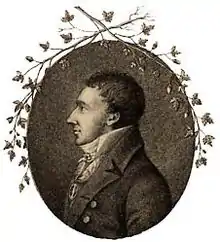
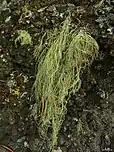
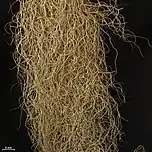
.jpg.webp)
_Hertel_%2526_A.J._Schwab_259698.jpg.webp)

.jpg.webp)
.jpg.webp)
.jpg.webp)
.JPG.webp)
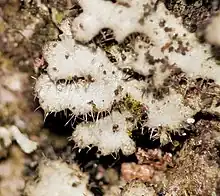
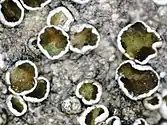
_Ach_271638.jpg.webp)
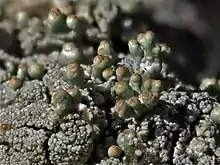
.jpg.webp)
_Taylor_455890.jpg.webp)